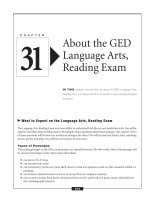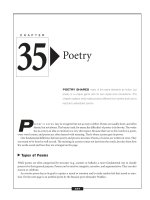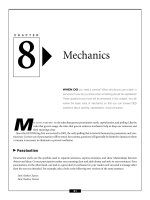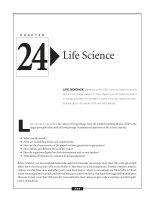The GED Language Arts,Writing Exam - Writing an Effective Essay
Bạn đang xem bản rút gọn của tài liệu. Xem và tải ngay bản đầy đủ của tài liệu tại đây (203.54 KB, 16 trang )
O
n Part II of the GED Language Arts, Writing Test, you will be asked to write a short essay about a
general topic, such as whether there is too much violence on television or what makes a good par-
ent.You will have 45 minutes to demonstrate how effectively you can express your ideas in writing.
A strong GED essay will have these five key elements:
1. Response to prompt (Does your essay present a well-developed main idea and a focus that responds to
the assigned prompt?)
2. Organization (Have you presented your ideas and support in a logical order?)
3. Development and details (Have you explained your ideas?)
4. Conventions of EAE (Have you followed the conventions of Edited American English?)
5. Word choice (Is the word choice accurate, diverse, and appropriate?)
As a general guide, you will need to write about four or five paragraphs to have a sufficiently developed essay.
That includes an introductory paragraph that states your main idea, two or three paragraphs developing and sup-
porting that main idea, and a brief concluding paragraph. Your essay should be approximately 250 to 300 words.
CHAPTER
Writing an
Effective Essay
PART II of the GED Language Arts, Writing Test has only one ques-
tion—an essay prompt. But this test is just as important as Part I, and
you must pass the essay test to pass the writing exam. This chapter
will teach you how to write an effective essay for the GED. You will
learn six steps to take during an essay exam, including how to brain-
storm and organize ideas and how to write with style.
10
75
General Writing Strategies
To do well on the essay exam, you need to have a solid
grasp of general writing strategies. These strategies are
those basic techniques writers use to develop a readable
and engaging text. They include:
■
writing in a way that is appropriate for audience
and purpose
■
providing appropriate and sufficient support
■
crafting effective introductions and conclusions
■
using effective transitions
■
revising for more effective writing
Audience and Purpose
At its core, effective writing has a constant awareness of
and attention to audience and purpose. Good writers are
always thinking about their readers: Who are they? What
do they know about the subject? What prejudices or pre-
conceived notions might they have? What will keep their
attention?
Good writers are also always thinking about purpose.
Is their goal to teach a lesson? Provide information?
Entertain? Answer a question? Convince or persuade?
W
RITING FOR
Y
OUR
A
UDIENCE
Knowing your audience will help you make a couple of
key writing decisions. First, it helps you determine your
level of formality. Will you use slang or very formal lan-
guage? It depends upon your relationship with your
reader. On the GED, you will be expected to write for a
general audience. That is, you should assume your read-
ers are “everyday” people with a wide variety of interests
and backgrounds. You will need an appropriate level of
formality for this audience. Treat your readers with
respect, but do not put them off by sounding too formal
or pretentious. Avoid slang (too informal) or jargon
(technical or specialized language). Let your writing be
natural without being too informal.
Your audience also determines the level of detail and
specificity in your essay. Because you are writing for a gen-
eral audience and not friends, you cannot assume that
readers know the context of your ideas and experiences.
For example, if you are arguing that Internet sites should
be censored, do not assume that readers have seen the
kind of sites you are talking about—or even that they
have been on the Internet. You will need to briefly
describe those sites to give your readers sufficient context.
K
NOWING
Y
OUR
P
URPOSE
As important as knowing whom you are writing for is
knowing why you are writing. What is the goal of your
essay? What are you hoping to convey through your writ-
ing? The more clearly you can articulate your purpose
while you outline your essay, the more effective your
writing and revising states will be.
Here are some verbs you might find helpful for
describing your purpose:
show describe explain
prove convince demonstrate
compare contrast review
inform summarize propose
defend explore encourage
Of course, your specific goals will be guided by the
prompt you receive on the GED. In a narrative essay, for
example, your main purpose will be to describe. In a per-
suasive essay, your main purpose will be to convince. In
an expository essay, you may aim to inform, compare,
propose, or explain, depending upon your topic.
As you think about how to write your essay, think
about how you would fill in the blank in the following
sentence:
My goal in this essay is to: .
Beginnings, Middles, and Ends
As you know, essays have three distinct parts:
■
beginning (introduction)
■
middle (body)
■
end (conclusion)
You will be expected to have all three parts in your
GED essay.
I
NTRODUCTIONS
First impressions count, and that’s why introductions are
so important in writing. A good introduction:
1. indicates what the essay is about (its topic) and
what the writer is going to say about the topic (its
main idea).
2. grabs the reader’s attention.
3. establishes the tone of the passage.
–
WRITING AN EFFECTIVE ESSAY
–
76
Techniques to grab attention include opening with:
■
a question
■
a quotation
■
a surprising fact or statement
■
an imaginary situation or scenario
■
an anecdote
■
interesting background information
■
a new twist on a familiar phrase
For example, a more attention-grabbing introduction
to the Batman passage in the pretest might be something
like the following:
Pow! Bam! Zap! Batman triumphs again, saving
the citizens of Gotham City from evil.
This opening plays upon a convention of comic strips
and the Batman television series. And because it is
unique and action-filled, it generates interest and excite-
ment in the reader.
C
ONCLUSIONS
Conclusions, too, should be powerful. After all, people
tend to remember most what comes first and last, and
the final words have the power to ring in readers’ ears for
a long time afterward. A good conclusion will:
1. restate the main idea.
2. provide a sense of closure (not “open a new can
of worms” by introducing a new topic).
3. arouse readers’ emotions to make the ending and
main idea memorable.
The Batman text, again, provides a good example.
In Batman, Kane gave us an image of our own
superhero potential.
This concluding sentence sums up what makes Batman
so popular, rounding out the passage in a way that makes
readers think about their own similarities to Batman and
what sort of superheroes they could be.
Many of the same introductory techniques can be
used to help make conclusions memorable:
■
a quotation
■
a question
■
an anecdote
■
a prediction
■
a solution or recommendation
■
a call to action
For example, the conclusion to an essay about a
healthy diet might end with a call to action:
Take a good, long look in your refrigerator and
pantry. What unhealthy foods call your icebox and
cabinets their home? Find them, get rid of them,
and stock up on foods that will help you live a
longer, healthier life.
Effective Essays and
the Writing Process
Experienced writers know that good writing doesn’t hap-
pen all at once. Rather, it develops in stages. That’s
because writing is a process, not just a product. And it’s
difficult to get a good product without going through
each step in the writing process.
The writing process can be divided into three steps:
1. planning
2. drafting
3. revising and editing
When you are under pressure to write a winning essay
in just 45 minutes, you may be tempted to skip these
steps and just write your essay in one shot. You may end
up with a successful essay with this approach. But your
chances of doing well on the GED Writing Test—or, on
any writing task—will increase dramatically if you take
the time to work through each step. Even though you
only have 45 minutes, the ten minutes you spend plan-
ning and proofreading your essay will be time well spent.
In fact, for essay exams, the planning stage is so impor-
tant that it has been divided into six separate steps in the
following section.
–
WRITING AN EFFECTIVE ESSAY
–
77
How to Divide Your Time
on an Essay Exam
When your time is limited, how long should you
spend on each step in the writing process?
On an essay exam, use this general rule for
dividing your time:
ᎏ
1
4
ᎏ
of the time: planning
ᎏ
1
2
ᎏ
of the time: writing
ᎏ
1
4
ᎏ
of the time: revising and editing
Your 45 minutes on the GED can be divided as
follows:
10 minutes planning
25 minutes writing
10 minutes revising and editing
Six Steps to a Strong Essay
These six steps will help you write a strong, effective essay
on the GED.
Step 1: Understand the Writing
Prompt
Before you can begin to plan your essay, you need to be
sure you understand the kind of essay you need to write.
As noted earlier, it is essential that you respond accu-
rately to the writing prompt you are given on the exam.
If you write about a different topic, you will not receive
credit for your essay. It’s therefore critical to understand
exactly what the prompt is asking you to do.
Earlier in this section, we divided the essay prompts
into three types: narrative, persuasive, and expository.
How do you know which kind of essay the prompt is ask-
ing for? Each prompt will have key words that can help
you understand what to do. These key words include
terms such as:
tell describe identify explain
Notice, for example, the underlined key words in the
two prompts below:
The Internet includes many websites with
images and content that are inappropriate for
children. Other sites on the Internet promote
violence or intolerance against certain groups of
people. Should websites like these be censored?
In your essay, stat
e your p
osition on this issue
and e
xplain
why you take that position. Use
your personal observations, experiences, and
knowledge to support your essay.
Sometimes, events take an unexpected turn and
things turn out differently than we imagined.
T
ell about a time when something unexpected
happened to you. In your essay, d
escribe what
was supposed to happen and how things actu-
ally turned out. Use supporting details through-
out your essay.
You are on your way to a successful essay if:
1. You understand what kind of essay to write:
narrative (tell a story), persuasive (make an argu-
ment), or expository (explain an idea or respond
to a situation or scenario).
2. You follow the directions exactly and directly
answer the questions in the prompt. In the first
example, you must state your position on the
issue raised in the prompt—censorship of cer-
tain types of Internet sites. In the second exam-
ple, you must tell a story about a specific kind of
experience—a time when something unexpected
happened.
Step 2: Formulate a Clear Thesis
Before you begin to write, you need to decide what you
are going to write about. Once you are sure you under-
stand the prompt, how will you answer its question? Your
answer will form the core of your essay. It will be the
main idea that controls everything you write and deter-
mine the kind of support you will provide. In other
words, your answer to the question in the prompt is your
thesis—your main idea. It is the “argument” that you are
going to make and the idea you need to support.
A thesis does not just repeat or paraphrase the ques-
tion or prompt. It does not simply make general state-
–
WRITING AN EFFECTIVE ESSAY
–
78
ments about the topic or state how others might respond
to the question. A good thesis takes a clear, personal posi-
tion. For example, look again at the following prompt:
Our relationships with our neighbors are very
important. Sometimes, these relationships are
the source of great joy in our lives; other times,
they can be the source of great trouble. In your
opinion, what makes a good neighbor? In your
essay, identify the characteristics of a good
neighbor and explain why these characteristics
are important for people living side by side. Use
your personal observations, experiences, and
knowledge to support your essay.
The following sentences are not thesis statements
(they do not answer the question).
■
There are all kinds of neighbors.
■
What makes a good neighbor?
■
There are many characteristics of a good
neighbor.
These, however, are thesis statements. They respond
directly to the question.
■
Good neighbors are helpful and kind.
■
The best kind of neighbors help when asked and
otherwise mind their own business.
■
Good neighbors are friendly, helpful, and respect-
ful of boundaries.
Step 3: Brainstorm Support for
Your Thesis
Once you have decided how to answer the question(s) in
the prompt, decide how you will support your answer.
On your piece of scrap paper, list at least three to five rea-
sons, examples, or specific details to support your thesis
or events to develop your story.
Because you are still in the planning stage, write down
whatever comes to mind. You don’t have to include
everything you list in your essay. And the more ideas you
put down, the more freedom you will have to pick the
best (strongest) support for your thesis.
For example, here’s how you might brainstorm sup-
port for the previous prompt:
T
hesis: Good neighbors are friendly, helpful,
and respectful of boundaries.
W
hy
?
Friendly neighbors are pleasant to have around,
make it nice to live where you live.
Helpful is important—know you can count on
them for small favors, when you are in need.
Need to respect boundaries, not take what
is yours, not get too involved in your life—
otherwise, they will not be welcome.
E
xamples:
Friendly—my neighbor Selma and her family—
always saying hello, often chatting, cookies at
Christmas.
Helpful—lending tools to Dad, borrowing sugar
etc., babysitting.
Respecting boundaries—don’t just walk in,
don’t be nosy; they’re your neighbors, not your
family.
Listing is just one brainstorming strategy. You can also
map your ideas. This is especially effective if you are a
visual learner, as shown on the map on the following page.
Freewriting
If you are totally stuck and can’t think of how to
answer your question or how to support your
thesis, try freewriting. This brainstorming tech-
nique is what it says—free writing. Write down
whatever comes to mind about the question or
topic. Don’t worry about grammar or structure.
Write in your own language if you like. Just
write. If you keep your hands moving for even
two or three minutes, you are bound to come
up with some good ideas.
–
WRITING AN EFFECTIVE ESSAY
–
79
–
WRITING AN EFFECTIVE ESSAY
–
80
Good
Neighbors
Nice to
be around
Friendly
Makes you
feel welcome
Feels
good
Greetings
Helpful
Small favors
Watering
garden
Accepting
packages
Baby-sitting
Borrowing
things
Sugar
Tools
Respect
boundaries
Donít have
to avoid
Pleasant for
everyone
Respect privacy
Respect
property
Don’t be
nosy
Mind own
business
Don’t take
each other’s
things









